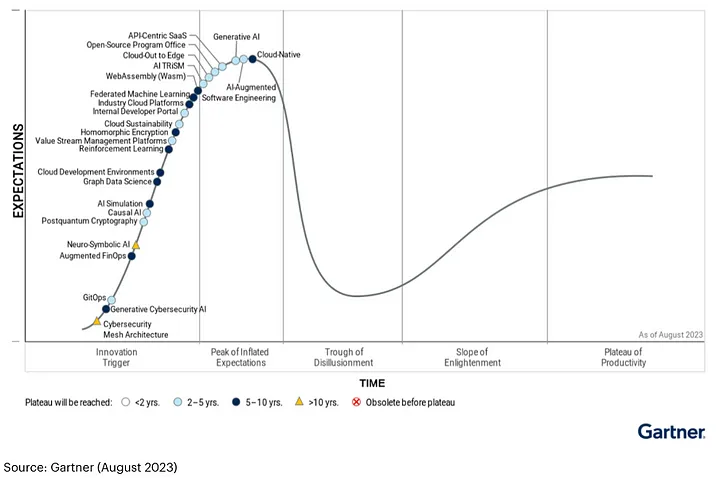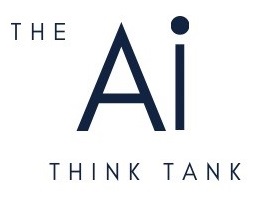In an era where artificial intelligence is reshaping numerous facets of our lives, Generative AI stands out as a ground-breaking frontier.
This technology doesn’t just analyse or process data; it creates — be it art, music, or even written content.
However, with innovation comes the inevitable “Hype Cycle”, a rollercoaster of rising expectations, followed by disappointments and, eventually, productive understanding.
In this blog post, we’ll embark on a journey through this cycle, helping you decipher the buzz surrounding Generative AI, understand its realistic potential, and ultimately guide you in making informed decisions amidst the hype.
Understanding the Hype Cycle

The Hype Cycle, coined by Gartner, a renowned research firm, offers a visual representation of the lifecycle stages a technology undergoes from inception to maturity and widespread adoption.
The model serves as a strategic tool, guiding business and enterprises in making informed decisions about investments, developments, and the deployment of new technologies.
Delving into the phases:
Innovation Trigger:
This marks the birth of the Innovation.
Here, an innovation or breakthrough sparks media attention and initial interest, even though the technology might not have a viable product in the market. It’s more of an idea or a possibility, setting the stage for potential development.
Peak of Inflated Expectations:
This phase is characterized by a surge of enthusiasm.
Early success stories, often accompanied by scores of failures, lead to inflated expectations. The buzz grows, and many assume the technology will be an immediate game-changer, even though it might still be in its infancy.
Trough of Disillusionment:
Reality sets in.
The initial excitement meets the challenges of real-world application.
Many implementations fail to deliver, leading to disillusionment and scepticism about the technology’s viability. It’s not uncommon for interest to wane, and investments may reduce.
Slope of Enlightenment:
Here, the collective understanding of the technology begins to crystallize.
Businesses recognize its practical applications and limitations. Through persistent experimentation and development, the technology’s true potential starts emerging, leading to more stable and value-driven implementations.
Plateau of Productivity:
At this mature phase, the technology’s benefits become widely acknowledged and accepted.
It demonstrates clear value and becomes a standard tool or practice in the industry. The adoption rate stabilizes, and the technology finds its rightful place in the market.
Understanding where a technology stands in the Hype Cycle is pivotal for businesses and individuals alike, ensuring they navigate the tumultuous journey of technological evolution effectively.
Generative AI in the Hype Cycle
Generative AI, with its unique ability to create novel content, has undoubtedly garnered immense attention, echoing the patterns we’ve seen with other emergent technologies.
When examining the Hype Cycle trajectories of past innovations, similarities emerge that can help us contextualize Generative AI’s journey.
Past trends:
Several ground-breaking technologies have traversed the Hype Cycle’s tumultuous pathway.
For instance, virtual reality (VR) once enjoyed an ascension to the Peak of Inflated Expectations, driven by dreams of transformative immersive experiences.
However, it soon plunged into the Trough of Disillusionment due to technological limitations and high costs.
Over time, with iterative enhancements and practical applications, VR began its climb up the Slope of Enlightenment and now approaches the Plateau of Productivity.
Similarly, blockchain experienced heightened expectations, followed by scepticism and then steady adoption as its true potential and applications became clear.
Current position of Generative AI:
Currently, Generative AI seems to hover near the Peak of Inflated Expectations.
The successes of models like GPT-3 have induced a mix of amazement and inflated projections about AI’s capabilities.
While the tech promises transformative applications, from art to research, it’s also met with concerns — whether about ethical implications, biases, or unrealistic expectations set by the public and even some stakeholders.
Predictions:
Anticipating the future trajectory of Generative AI is challenging due to its dynamic nature.
However, given historical patterns, it’s likely we’ll witness a calibration of expectations soon.
Generative AI might face disillusionment, especially as limitations become evident.
Yet, as researchers and practitioners refine the technology, explore ethical considerations, and unearth practical applications, we can anticipate a rise along the Slope of Enlightenment.
Over the coming years, as the technology matures and integrates into diverse sectors, Generative AI will likely settle into its Plateau of Productivity, redefining many industries’ landscapes.
Understanding Generative AI’s position in the Hype Cycle can aid stakeholders in making informed choices, mitigating risks, and maximizing the technology’s vast potential.
Navigating the Hype Cycle for Generative AI
As Generative AI gains prominence, discerning its position on the Hype Cycle becomes essential for entrepreneurs and businesses.
Each phase presents unique challenges and opportunities, demanding different strategies for effective navigation.
How to identify where you are on the curve:
To identify where you are on the Hype Cycle for generative AI, consider the following questions:
Are you aware of the latest developments in generative AI?
- Do you have a clear understanding of the potential applications of generative AI to your business?
- Are you already using generative AI in any way?
- Are you planning to invest in generative AI in the future?
If you are not yet aware of the latest developments in generative AI, or if you do not have a clear understanding of its potential applications, then you are probably in the early stages of the Hype Cycle.
If you are already using generative AI in some way, or if you are planning to invest in it in the future, then you are probably further along the Hype Cycle.
Strategies to Navigate the Generative AI Hype Cycle
Navigating the turbulent waters of the Generative AI hype cycle requires a balanced mix of enthusiasm, realism, and strategic thinking. Here’s an expanded guide on how to do so:
#1: Be Realistic: Acknowledge the Boundaries
While the promise of Generative AI is vast, it’s essential to ground oneself in reality. Every technology has its strengths and weaknesses. Understand that Generative AI needs vast datasets to train, and even then, it may not be perfect. The computational demands can be significant, and the technology may not fit every scenario. Keep these constraints in mind to set achievable goals.
#2: Focus on Use Cases: Tailor to Needs
Rather than chasing every possible application, pinpoint areas in your business or project where Generative AI can make a tangible difference. Whether it’s generating creative content, running data simulations, or developing predictive models, align the technology with the problem it’s best suited to address.
#3: Partner with Experts: Harness Specialized Knowledge
Navigating the nuances of Generative AI can be challenging. Collaborating with professionals who have hands-on experience in this domain ensures that you’re on the right path. Their expertise can help you sidestep common pitfalls, optimize processes, and achieve desired outcomes.
#4: Be Patient: Trust the Journey
Remember that Generative AI, like all innovative tech, is in a state of constant evolution. While you might face hurdles initially, enduring advancements are on the horizon. Investing time and resources now could lead to substantial dividends in the future. Stay the course and allow the technology the time it needs to mature.
#5: Experiment and Learn: Adapt and Evolve
In the realm of Generative AI, there’s no substitute for hands-on experience. Start with pilot projects or limited applications to get a feel for its capabilities and limitations. These initial endeavours will not only provide valuable feedback but also shape your broader strategy, ensuring that subsequent, more extensive deployments are fine-tuned to perfection.
In essence, steering through the Generative AI hype cycle is about combining informed strategy with a spirit of discovery. Stay curious, stay informed, and be ready to harness the transformative potential of Generative AI.
Looking Ahead — The Future of Generative AI
As we traverse beyond the peaks and troughs of hype, the realistic potential of Generative AI begins to crystallize.
While it’s not a panacea, its prowess in synthesizing content, simulating data, and predictive modeling is undeniable.
The next wave of growth will likely be propelled by applications in personalized content creation, medicine (like drug discovery), virtual reality, and even areas like climate modeling.
However, this transformative power doesn’t come without its caveats.
Ethical dilemmas loom large, especially as the line blurs between human-generated and AI-generated content. Issues of data privacy, potential misuse (like deepfakes), and AI bias need addressing.
As we embrace Generative AI’s capabilities, it’s imperative to foster a landscape of responsibility, ensuring that the technology serves societal well-being, upholds integrity, and promotes equitable outcomes.

